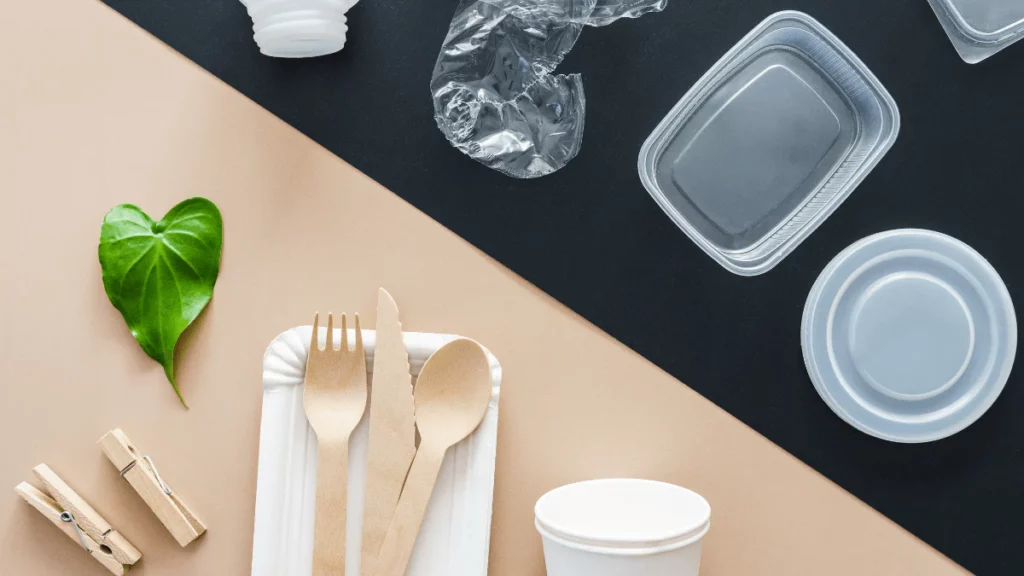Sustainability is a very important issue today due to the effects of waste and pollution. Increasingly severe deforestation, climate change, and plastic pollution have consumers on the lookout for more sustainable substitutes for traditional materials. One of the most debated arguments in the sustainability movement is the battle of bamboo versus plastic.
Despite bamboo being marketed as a greener substitute, plastic continues to dominate the market in numerous industries. Is bamboo better? Or does plastic have the edge in some areas? This article aims to examine the truth of sustainability by using a comparative analysis of bamboo and plastic’s sustainability, encapsulating their environmental effects, durability, cost, and overall adaptability to various applications.
Impact on the Environment: Bamboo vs. Plastic
Bamboo is most frequently praised, and for good reason; it is effortlessly one of the most sustainable materials on the globe. Certain species can grow as much as three feet in a single day. It’s renewable since bamboo can be harvested without killing the plant, and unlike conventional trees, it does absorb copious amounts of carbon dioxide, aiding in the fight against global warming. Furthermore, bamboo products are environmentally safe since they are fully biodegradable, which means they don’t pollute the environment by breaking down naturally.
In contrast, plastic is well known for its adverse effects on the environment. Its production and manufacturing processes alone emit substantial amounts of greenhouse gases. Being a derivative of petroleum, which is a non-renewable fossil fuel, plastic takes hundreds of years to decompose, unlike bamboo. This contributes to the mass of waste stored in landfills and oceans. Plastic pollution is a worldwide epidemic that destroys marine ecosystems, contaminates water bodies, and adds to the growing problem of microplastic pollution. The eco-friendly alternatives to plastic are very cost-ineffective, which, when compared to the environmental damages caused by their production or disposal, become exorbitant.
Durability and Longevity: Which Material Lasts Longer?
The unrivaled convenience that plastic offers is one of the reasons for its popularity. Plastic is resistant to chemicals, heat, and water, making it durable and hard-wearing. While plastic products that last for decades decrease the need for replacements and therefore serve eco-friendly goals, the stark reality is that these will contribute to environmental damage virtually forever.
Bamboo has strength and flexibility, but it is not as strong as plastic under certain conditions. Moreover, it easily absorbs moisture, which can lead to swelling, warping, or mold growth over time. Products made of bamboo require special treatments, such as waterproofing and lamination, to enhance their longevity. Regardless, bamboo is a suitable substitute for many applications, especially short-lived ones or those intended to disintegrate, such as utensils, straws, and packaging materials.
Cost Comparison: Bamboo vs. Plastic
In comparison with bamboo, plastic is relatively less expensive to produce and purchase. The mass production of plastic using cheap raw materials makes it cost-effective for businesses. Therefore, plastic packaging, containers, and other household products are usually more affordable than bamboo ones.
Due to the careful harvesting and processing of this resource, bamboo tends to be more expensive. This is due to the sustainable, labor-intensive production, which increases the cost of bamboo products. However, with rising consumer demand for environmentally friendly products, the price of bamboo is slowly declining. In the end, the high cost of bamboo makes it an appealing investment for environmentally conscious people who value sustainability.
Health and Safety Issues:
Bamboo takes the throne when compared to plastic from a health and safety perspective. A plethora of plastic products use BPA (bisphenol A) and phthalates, which are harmful to the human body and leach into food and drinks. These plastics are known to cause serious health complications and lie in the region of disrupting the endocrine system, leading to issues with reproduction and, in some cases, cancer.
Bamboo is safe to use with food as it does not include toxic chemicals, but some bamboo products do, such as bamboo fiber utensils and dishware that contain glues or melamine. These products are known to emit dangerous chemicals when subjected to great heat. To be on the safer side, it is advisable to choose items that are labeled “organic” or “100% natural bamboo,” as they are guaranteed not to contain harmful substances.
What Role Recycling and Waste Management Play:
For years, the world has believed that recycling plastic is a solution to controlling waste, but the shocking truth is that only a small percentage of plastic is actually recycled. Many types of plastic are non-recyclable due to them being contaminated, being composed of mixed materials, or lacking proper facilities to recycle them. This accounts for a significant percentage of plastic waste that is stored in landfills, burned, or dumped in water bodies.
Bamboo products are decomposable, which means they break down over time without damaging the ecosystem. Even in a disposed state, bamboo is comparatively less harmful to the environment than plastic, as it decomposes more rapidly. Moreover, some bamboo products, such as furniture and flooring, can be reclaimed or composted at the end of their life cycle, enhancing sustainability.
Sectors Employing Bamboo as a Sustainable Alternative:
Numerous sectors are beginning to adopt bamboo in place of plastic for its sustainability. The fashion industry, for instance, is lowering the use of artificial clothing materials by adding bamboo fibers into clothes. The construction sector has also adopted the use of bamboo for building due to its strong and renewable nature.
Bamboo is overtaking plastic in everyday goods such as toothbrushes, straws, utensils, and packaging. Even some technology firms are venturing into the use of bamboo for eco-friendly mobile phone cases, laptop covers, and other add-ons. This change emphasizes the increasing understanding of the use of bamboo as an eco-sustainable alternative.
Limitations on the Production and Sustainability of Bamboo:
Bamboo’s many advantages are countered by some challenges. Poor management of bamboo plantations can lead to deforestation, decreased biodiversity, and overuse of pesticides. These problems only worsen with increased transportation of bamboo from Asia to the rest of the world, as this increases the carbon footprint of bamboo.
Separating bamboo into strip form and manufacturing it into finished products already poses a challenge, but some items also require chemical treatments, glues, or coatings that further strip the product of its environmental benefits. Consumers must ensure true sustainability by purchasing responsibly sourced certified bamboo products, as it becomes the brand’s responsibility to prove they are eco-friendly.
Bamboo vs. Plastic on Sustainability:
There are benefits and challenges to both bamboo and plastic, but on a sustainability level, the former takes the lead. As a renewable and biodegradable resource, its impact on the environment is substantially less than that of plastic. That said, there are some applications where plastic takes the lead on strength, cost, and adaptability.
In general, decreasing plastic consumption where possible is ideal, substituting bamboo and other eco-friendly materials. Good practices of material selection rely on the collaborative efforts of governments, businesses, and the general population. Supporting and using eco-friendly products and sustainable solutions ensures a reduced environmental footprint on the planet and enables the creation of a cleaner and healthier Earth.
Conclusion:
One of the most debated topics in the movement toward sustainability is the use of bamboo versus plastic. Plastic is easy to obtain and quite cheap, but it causes tremendous harm to the environment in the long run. Bamboo, on the other hand, has a renewable nature as well as biodegradability, making it greener and more sustainable.
However, like any other material, it has limitations. Sustainability relies on making informed choices, reducing waste, supporting responsible production, and opting for bamboo-based products while minimizing the use of plastic. It’s a collective effort by people, businesses, and government to become serious about the state of our environment and consider its health above convenience.
FAQs:
1. Is bamboo always a better option than plastic?
Not necessarily. Bamboo is more sustainable than plastic, but its production and transportation can have environmental consequences. It all depends on the use and the business’s sourcing policies.
2. Does bamboo have the ability to replace plastic in all sectors?
No. Certain medical, industrial, and technological fields need plastic for its durability and safety. However, bamboo can replace plastic in many consumer goods.
3. In what ways can I determine that a bamboo product is sustainable?
The product should have a certification from the Forest Stewardship Council or an equivalent body, and it should be free of any synthetic or toxic compounds.
4. Is a large volume of water needed for bamboo cultivation?
No. Bamboo uses much less water than conventional trees, which makes it a more water-efficient crop.
5. Is the cost of bamboo products lower than that of plastic products?
Yes. Due to sustainable harvesting and processing, bamboo products tend to be more expensive, although this is changing as demand increases.

